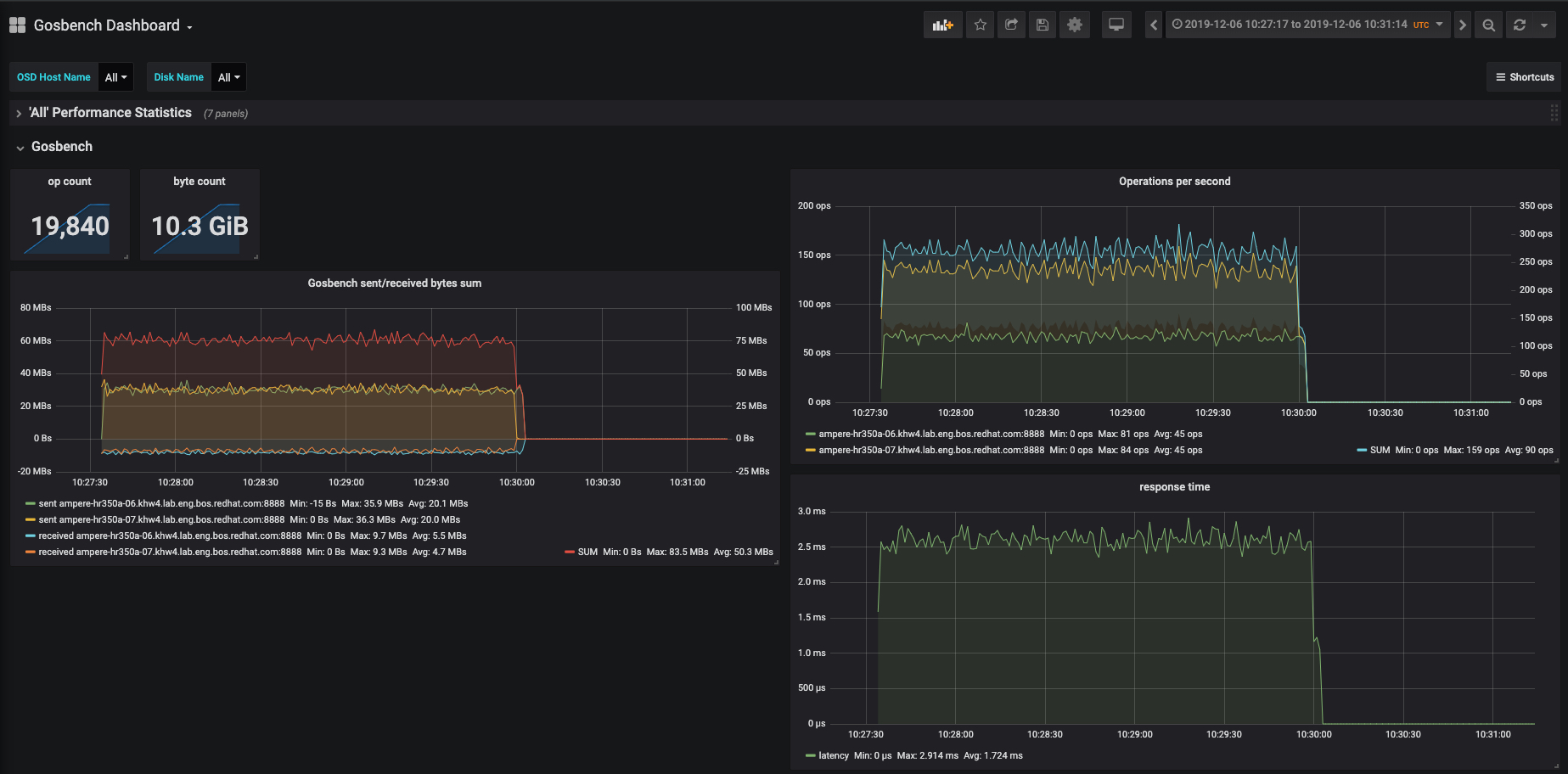Gosbench is the Golang reimplementation of Cosbench. It is a distributed S3 performance benchmark tool with Prometheus exporter leveraging the official Golang AWS SDK
Gosbench consists of two parts:
- Server: Coordinates Workers and general test queue
- Workers: Actually connect to S3 and perform reading, writing, deleting and listing of objects
INFO: -d activates debug logging, -t activates trace logging
- Build the server:
go install github.com/mulbc/gosbench/server - Run the server, specifying a config file:
server -c path/to/config.yaml- you can find an example config in the example folder - The server will open port 2000 for workers to connect to - make sure this port is not blocked by your firewall!
- Build the worker:
go install github.com/mulbc/gosbench/worker - Run the worker, specifying the server connection details:
worker -s 192.168.1.1:2000 - The worker will immediately connect to the server and will start to get to work. The worker opens port 8888 for the Prometheus exporter. Please make sure this port is allowed in your firewall and that you added the worker to the Prometheus config.
Make sure your prometheus configuration looks similar to this:
global:
scrape_interval: 15s # Set the scrape interval to every 15 seconds. Default is every 1 minute.
evaluation_interval: 15s # Evaluate rules every 15 seconds. The default is every 1 minute.
scrape_configs:
- job_name: 'prometheus'
static_configs:
- targets:
- localhost:9090
- job_name: 'gosbench'
scrape_interval: 1s
static_configs:
- targets:
- WORKER1.example.com:8888
- WORKER2.example.com:8888To reload the configuration, you can either send a SIGHUP to your prometheus server or just restart it ;) Afterwards ensure that you have your Gosbench workers listed at http://your.prometheus.server.example.com:9090/targets
It is expected that the workers are in state DOWN most of the time... they are only scrapeable during a test run.
It is Best Practice to run the Prometheus Node Exporter on all hosts as well, to gather common system metrics during the tests. This will help you in identifying bottlenecks. Please consult the Node Exporter manuals on how to install and configure it on your platform.
During a test, Prometheus will scrape the performance data continuously from the workers. You can visualize this data in Grafana. To get an overview of what the provided data looks like, check out the example scrape.
There is also an example Grafana dashboard that you can import and use. The Dashboard has some basic overview of the most common stats that people are interested in:
There are now Docker container images available for easy consumption:
docker pull quay.io/mulbc/goroom-server
docker pull quay.io/mulbc/goroom-workerIn the k8s folder you will find example files to deploy Gosbench on Openshift and Kubernetes.
Be sure to modify the ConfigMaps in gosbench.yaml to use your S3 endpoint credentials.
Due to popular demand, reading pre-existing files have been added. You activate this special mode by setting existing_read_weight to something higher than 0.
There are some important things to consider though ;)
Just like with other operations, the bucket_prefix value will be evaluated to determine the bucket name to search for pre-existing objects.
Example: This is an excerpt of your config:
objects:
size_min: 5
size_max: 100
part_size: 0
# distribution: constant, random, sequential
size_distribution: random
unit: KB
number_min: 10
number_max: 100
# distribution: constant, random, sequential
number_distribution: constant
buckets:
number_min: 2
number_max: 10
# distribution: constant, random, sequential
number_distribution: constant
bucket_prefix: myBucket-Note: Due to the constant distribution, we will only consider the _min values.
This will cause each workers to search for pre-existing files in the buckets myBucket-0 and myBucket-1 and read 10 objects from these buckets. If there are less than 10 objects in any of these buckets, some objects will be read multiple times. The object size given in your config will be ignored when reading pre-existing files.
- Be aware that this repo uses pre-commit hooks - install them via
pre-commit install - We are using Go modules in this repository - read up on it here
- Check out the open TODOs for hints on what to work on
- Workers will error out when the config's min value is larger than the max value (even for a constant distribution)
